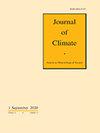Impact of Summer North Atlantic Sea Surface Temperature Tripole on Precipitation over Mid–high-latitude Eurasia
IF 4
2区 地球科学
Q1 METEOROLOGY & ATMOSPHERIC SCIENCES
引用次数: 0
Abstract
Abstract Eurasia is a sensitive and high-risk region for global climate changes, where climate anomalies significantly influence natural ecosystems, human health, and economic development. The North Atlantic tripole (NAT) sea surface temperature anomaly is crucial to interannual precipitation variations in Eurasia. Several studies have focused on the link between the NAT and climate anomalies in winter and spring. However, the mechanism by which the summer NAT impacts climate anomalies in Eurasia remains unclear. This study examines how the NAT impacts interannual variations of summer precipitation in mid-high-latitude Eurasia. Precipitation variations are associated with the atmospheric teleconnection triggered by the NAT. When the NAT is in its positive phase, the anomalous atmospheric diabatic heating over the North Atlantic excites an equivalent-barotropic Rossby wave train response that propagates eastward toward the Eurasia, resulting in atmospheric circulation anomalies over the region. The combined effects of atmospheric circulation, radiative forcing, and water vapor transport anomalies lead to decreased precipitation across Northern Europe and central Eurasia, with higher precipitation anomalies over the Northeast Asia. Finally, numerical experiments verify that the summer NAT excites atmospheric teleconnections that propagate downstream, affecting precipitation anomalies in mid-high-latitude Eurasia. This study provides a scientific basis for predicting Eurasian summer precipitation and strengthening disaster management strategies.夏季北大西洋海面温度三极对欧亚大陆中高纬度降水的影响
摘要 欧亚大陆是全球气候变化的敏感和高风险地区,那里的气候异常严重影响着自然生态系统、人类健康和经济发展。北大西洋三极海面温度异常对欧亚大陆年际降水量变化至关重要。一些研究重点关注北大西洋三极与冬季和春季气候异常之间的联系。然而,夏季 NAT 对欧亚大陆气候异常的影响机制仍不清楚。本研究探讨了欧亚大陆中高纬度地区夏季降水量的年际变化如何受 NAT 影响。降水量的变化与 NAT 引发的大气远程联系有关。当 NAT 处于正相位时,北大西洋上空异常的大气绝热加热会激发等效各向同性的罗斯比波列响应,并向东传播到欧亚大陆,从而导致该地区的大气环流异常。大气环流、辐射强迫和水汽输送异常的综合效应导致北欧和欧亚大陆中部降水量减少,而亚洲东北部降水量异常增加。最后,数值实验验证了夏季 NAT 激发了大气远距离联系,并向下游传播,影响了欧亚大陆中高纬度地区的降水异常。这项研究为预测欧亚大陆夏季降水和加强灾害管理策略提供了科学依据。
本文章由计算机程序翻译,如有差异,请以英文原文为准。
求助全文
约1分钟内获得全文
求助全文
来源期刊

Journal of Climate
地学-气象与大气科学
CiteScore
9.30
自引率
14.30%
发文量
490
审稿时长
7.5 months
期刊介绍:
The Journal of Climate (JCLI) (ISSN: 0894-8755; eISSN: 1520-0442) publishes research that advances basic understanding of the dynamics and physics of the climate system on large spatial scales, including variability of the atmosphere, oceans, land surface, and cryosphere; past, present, and projected future changes in the climate system; and climate simulation and prediction.
 求助内容:
求助内容: 应助结果提醒方式:
应助结果提醒方式:


